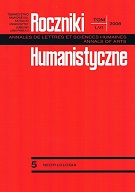Bridging and the Phonology-morphology Interface
Bridging and the Phonology-morphology Interface
Author(s): Anna Bloch-RozmejSubject(s): Language and Literature Studies
Published by: Towarzystwo Naukowe KUL & Katolicki Uniwersytet Lubelski Jana Pawła II
Keywords: morphohonology; bridging; licensing; parameter; elements; morofonologia; relacja pomostowa bridging; licencjonowanie; parametr; elementy
Summary/Abstract: Apart from purely phonological and purely morphological phenomena attested in the systems of languages, there are certain areas where close cooperation of the two disciplines can be observed. Consequently, the phonetic outcome can often result from an interplay of both phonological and morphological factors. It sometimes happens that the mere establishing of domain boundaries proves insufficient in accounting for certain forms occurring in particular languages. Evidence can be found supporting the intuition that individual languages employ specific mechanisms capable of manifesting the phonology/morphology interaction in producing concrete phonetic representations. The presentation to be delivered will be couched within the non-linear framework of Government Phonology. We shall dwell on the hypothesis formulated in Bloch-Rozmej (1998) to the effect that segments and their corresponding constituents are capable of contracting a special type of a licensing relation that we call Bridging. An inter-element, or inter-constituent, bridge can, in response to language-specific requirements and parameter-settings, be resorted to in accounting for either purely phonological or morpho-phonological phenomena. The bridging mechanism can, but does not have to, overlap with inter-onset government, thus bringing about different results. The existence of such a bridging – interonset government combination is a language-specific property. In this presentation our attention will be drawn to a number of processes found in Irish, German and Korean that can readily be accounted for once the relation of bridging has been employed. Connemara Irish can be argued to exhibit the workings of bridging as a mechanism underlying the process of nasal lenition. The example of Irish illustrates the operation of bridging as a device used for purely phonological purposes. The system of Irish allows for the contraction of inter-onset bridging domains as a reflection of its susceptibility to the requirements of the Obligatory Contour Principle (MCCARTHY 1986).
Journal: Roczniki Humanistyczne
- Issue Year: 56/2008
- Issue No: 05
- Page Range: 49-62
- Page Count: 14
- Language: English

